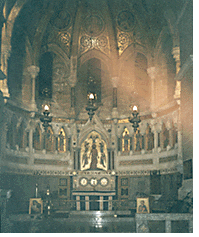...Best of Sicily
presents... Best of Sicily Magazine. ... Dedicated to Sicilian art, culture, history, people, places and all things Sicilian. |
by Ignazio Lo Verde | ||
Magazine Best of Sicily Arts & Culture Fashion Food & Wine History & Culture About Us Travel Faqs Contact Map of Sicily |
The Inghams and Whitakers defrayed the expense of planning and construction. The chief architect was William Barber of London. Opening in 1875, the church was incorporated into the Diocese of Gibralter the following year. Its Neo-Gothic grandeur --pointed arches, stained glass, a rose window-- creates a stunning effect. Saints are represented in mosaic and stained glass. Devonshire marble complements Carrara and local stone. Salviati of Venice executed the mosaics, while the stained glass windows are from London. The contemporary Anglican chapels at Taormina and Marsala were altogether more austere. Until the Second World War, the Church of the Holy cross was a point of reference for British troops passing through Palermo. During the war, a bomb blast near the church destroyed the colored glass in several windows, replaced several years later. Fallen foreigners have been commemorated here on two particular occasions --in August 1943 during the Allied occupation and in September 2001 after the World Trade Center bombings. The plaque dedicated by General George Patton reads simply: "To the Glory of God. In memory of the heroic Americans of the seventh Army and the supporting units of the Navy and Air Force who gave their lives for victory in the Sicilian campaign July 10-August 17 1943. From their General." That general's identity is represented by three stars. Except for a cemetery near Catania, this plaque is the only Allied memorial in Sicily. At the more recent memorial service in 2001, a multinational congregation sang My Country 'Tis of Thee and God Save the Queen to the same music. A fitting remembrance in a church with a polyglot heritage. About the Author: Professor Ignazio Lo Verde lectures on classics and architecture. | |
Top of Page |
 In the truest sense, it was once the "Anglo-American" chapel of Sicily, the place of worship, in a bygone era, of British sovereigns, American generals and visiting dignitaries. Their names resound in the annals of history: Edward VII, George V, Queen Mary, Montgomery, Patton. Central Palermo seems an unconventional place for an Anglican church, but this one has stood at the corner of Via Roma and Via Mariano Stabile since before either street existed. Today, when neither the United States or the United Kingdom has so much as an accredited Consul in Sicily, when the British and American communities in Palermo are virtually anonymous, the church's role is far less prominent than it was in the past. But for all its viscissitudes, the history of Holy Cross Church is an aristocratic one rooted in the culture of Sicily herself. It begins in the early years of the nineteenth century, with a displaced Englishman named Benjamin Ingham, one of the people who developed the fortified wine industry in Marsala in 1806, following in the footsteps of John Woodhouse, another Englishman, who had arrived in 1770. Ingham's nephews, the Whitakers, chose Palermo to the more provincial ambience of Marsala, building Villa Malfitano, the Italianate Art Nouveau ("Liberty") mansion near the Zisa Castle (on the street now called Via Dante). In fact, Villa Malfitano rather resembles a hall one might find on an English country estate, and in its heyday hosted lavish parties attended by British and Italian royalty. Appropriately, the Whitaker's church is similar to what one could expect to find in an old English manor. Like several other English families in Palermo (the Brookes and Tidswells come to mind), they were descended from the landed gentry.
In the truest sense, it was once the "Anglo-American" chapel of Sicily, the place of worship, in a bygone era, of British sovereigns, American generals and visiting dignitaries. Their names resound in the annals of history: Edward VII, George V, Queen Mary, Montgomery, Patton. Central Palermo seems an unconventional place for an Anglican church, but this one has stood at the corner of Via Roma and Via Mariano Stabile since before either street existed. Today, when neither the United States or the United Kingdom has so much as an accredited Consul in Sicily, when the British and American communities in Palermo are virtually anonymous, the church's role is far less prominent than it was in the past. But for all its viscissitudes, the history of Holy Cross Church is an aristocratic one rooted in the culture of Sicily herself. It begins in the early years of the nineteenth century, with a displaced Englishman named Benjamin Ingham, one of the people who developed the fortified wine industry in Marsala in 1806, following in the footsteps of John Woodhouse, another Englishman, who had arrived in 1770. Ingham's nephews, the Whitakers, chose Palermo to the more provincial ambience of Marsala, building Villa Malfitano, the Italianate Art Nouveau ("Liberty") mansion near the Zisa Castle (on the street now called Via Dante). In fact, Villa Malfitano rather resembles a hall one might find on an English country estate, and in its heyday hosted lavish parties attended by British and Italian royalty. Appropriately, the Whitaker's church is similar to what one could expect to find in an old English manor. Like several other English families in Palermo (the Brookes and Tidswells come to mind), they were descended from the landed gentry.